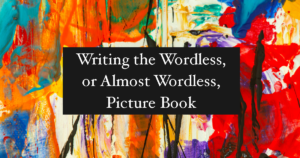 In honor of National Reading Month (March), and many other fine celebratory days this month, let’s take a look at a book for the very youngest reader/listener. After all, it is never too early to start reading to your child. But how does a writer write a wordless, or almost wordless, book? And how is it done if the writer is not also an illustrator?
In honor of National Reading Month (March), and many other fine celebratory days this month, let’s take a look at a book for the very youngest reader/listener. After all, it is never too early to start reading to your child. But how does a writer write a wordless, or almost wordless, book? And how is it done if the writer is not also an illustrator?
Obviously, one cannot simply list the few words that appear on the pages and submit that as a picture book manuscript. An editor would have no idea what is happening in the world of the story. And yet, we know that writers do not tell illustrators how to do the artwork by inserting tons of illustration notes in our submissions.
A Case Study
My books MINE! and UH-OH! (published by Alfred A. Knopf/Random House) came out in board book format after their runs in hardcover. Both received good reviews and of MINE! the NY Times said, “… a delightful example of the drama and emotion that a nearly wordless book can convey.” That book has 9½ repetitions of the single word mine and a lone woof in the text. So how did I submit it?
One might think that the illustrator Patrice Barton and I partnered-up on the submission and that it went to our editor with a dummy layout for the picture book. But that is not what happened. In a traditional manner, the manuscript was submitted to a traditional publisher without a dummy and the illustrator was selected later. In most cases of traditional picture book publishing the author has no say in who will be chosen to illustrate. This was the case with both these books.
What Worked
If you are struggling with how best to present your wordless, or nearly wordless, manuscript and you are not an illustrator, here is what worked for these books. Perhaps this method will also work for you.
I set the scene with a note under the title, and then detailed the string of related actions (physical and emotional) that make up the plot arc—almost like a play is written, in beats. While doing this, I was careful not to tell the illustrator how to illustrate the book. In the note there is no mention of type of dog, of what kind of world this takes place in (except we see the kids down on a kitchen floor), etc. I needed to simply state what actions, and the emotional response to those actions, had to be evident in the illustrations for the plot to work. The only dialogue spoken I printed in bold print in the submission.
To see how this two-page, 9½ word story looked when it was submitted, click here: MINE! First page.
Go For It and Celebrate
If you can visualize a short movie in your head, and the beats needed to enact it, you’re already a long way toward writing the wordless or nearly wordless book for young readers. You don’t need to be an illustrator. Don’t let that worry hold you back. And once your book gets accepted—celebrate!
Hey, it’s also National Celery Month. And March 20th is Extraterrestrial Abduction Day. If you get abducted take a lot of celery with you to munch on, and your manuscript to work on. Then let us know what it’s like out there! (Might make a lovely picture book.)

Rebecca Van Slyke
Thanks for the peek into your process!
Lynnmarie May
This is exactly the information I’ve needed. Thank you very much!